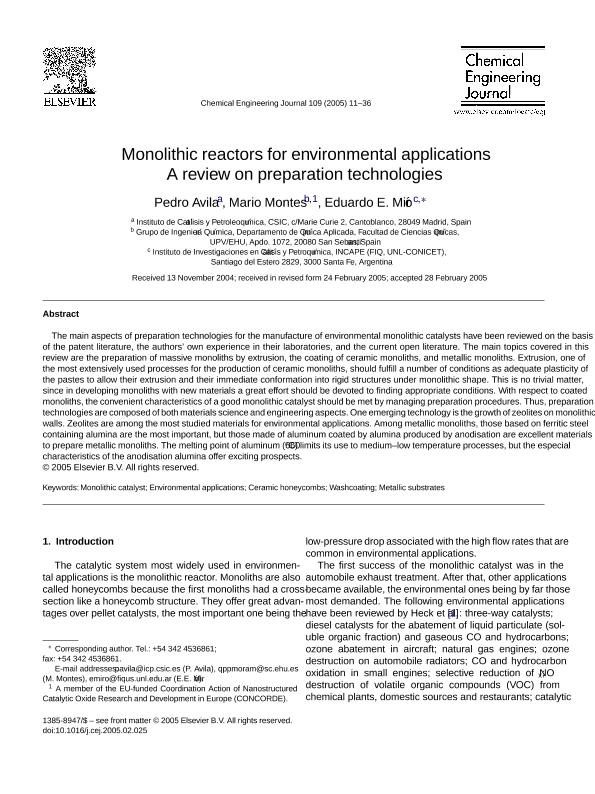Mostrar el registro sencillo del ítem
dc.contributor.author
Avila, Pedro
dc.contributor.author
Montes, Mario
dc.contributor.author
Miro, Eduardo Ernesto

dc.date.available
2019-06-12T11:25:10Z
dc.date.issued
2005-05
dc.identifier.citation
Avila, Pedro; Montes, Mario; Miro, Eduardo Ernesto; Monolithic reactors for environmental applications: A review on preparation technologies; Elsevier Science Sa; Chemical Engineering Journal; 109; 1; 5-2005; 11-36
dc.identifier.issn
1385-8947
dc.identifier.uri
http://hdl.handle.net/11336/78021
dc.description.abstract
The main aspects of preparation technologies for the manufacture of environmental monolithic catalysts have been reviewed on the basis of the patent literature, the authors' own experience in their laboratories, and the current open literature. The main topics covered in this review are the preparation of massive monoliths by extrusion, the coating of ceramic monoliths, and metallic monoliths. Extrusion, one of the most extensively used processes for the production of ceramic monoliths, should fulfill a number of conditions as adequate plasticity of the pastes to allow their extrusion and their immediate conformation into rigid structures under monolithic shape. This is no trivial matter, since in developing monoliths with new materials a great effort should be devoted to finding appropriate conditions. With respect to coated monoliths, the convenient characteristics of a good monolithic catalyst should be met by managing preparation procedures. Thus, preparation technologies are composed of both materials science and engineering aspects. One emerging technology is the growth of zeolites on monolithic walls. Zeolites are among the most studied materials for environmental applications. Among metallic monoliths, those based on ferritic steel containing alumina are the most important, but those made of aluminum coated by alumina produced by anodisation are excellent materials to prepare metallic monoliths. The melting point of aluminum (660 °C) limits its use to medium-low temperature processes, but the especial characteristics of the anodisation alumina offer exciting prospects.
dc.format
application/pdf
dc.language.iso
eng
dc.publisher
Elsevier Science Sa

dc.rights
info:eu-repo/semantics/openAccess
dc.rights.uri
https://creativecommons.org/licenses/by-nc-sa/2.5/ar/
dc.subject
Ceramic Honeycombs
dc.subject
Environmental Applications
dc.subject
Metallic Substrates
dc.subject
Monolithic Catalyst
dc.subject
Washcoating
dc.subject.classification
Otras Ingeniería Química

dc.subject.classification
Ingeniería Química

dc.subject.classification
INGENIERÍAS Y TECNOLOGÍAS

dc.title
Monolithic reactors for environmental applications: A review on preparation technologies
dc.type
info:eu-repo/semantics/article
dc.type
info:ar-repo/semantics/artículo
dc.type
info:eu-repo/semantics/publishedVersion
dc.date.updated
2019-04-01T16:11:03Z
dc.journal.volume
109
dc.journal.number
1
dc.journal.pagination
11-36
dc.journal.pais
Países Bajos

dc.journal.ciudad
Amsterdam
dc.description.fil
Fil: Avila, Pedro. Instituto de Catálisis y Petroleoquímica; España
dc.description.fil
Fil: Montes, Mario. Universidad del País Vasco; España
dc.description.fil
Fil: Miro, Eduardo Ernesto. Consejo Nacional de Investigaciones Científicas y Técnicas. Centro Científico Tecnológico Conicet - Santa Fe. Instituto de Investigaciones en Catálisis y Petroquímica "Ing. José Miguel Parera". Universidad Nacional del Litoral. Instituto de Investigaciones en Catálisis y Petroquímica "Ing. José Miguel Parera"; Argentina
dc.journal.title
Chemical Engineering Journal

dc.relation.alternativeid
info:eu-repo/semantics/altIdentifier/doi/http://dx.doi.org/10.1016/j.cej.2005.02.025
Archivos asociados
